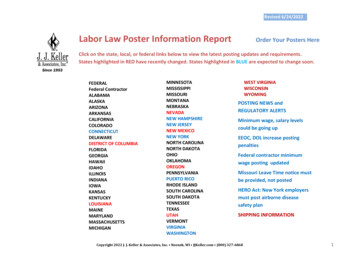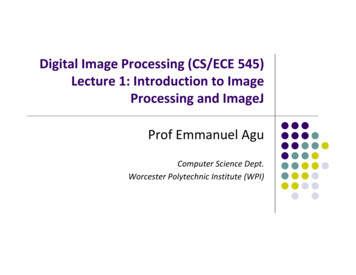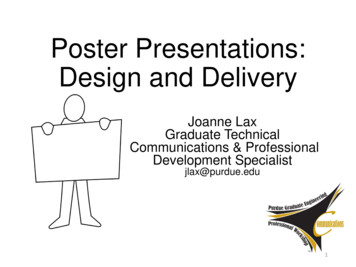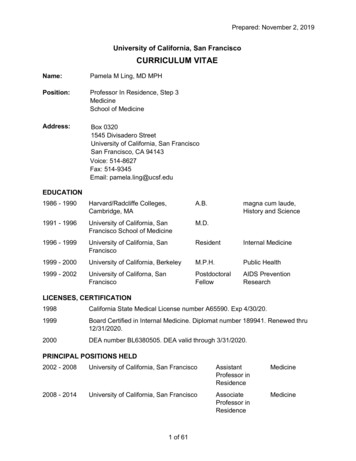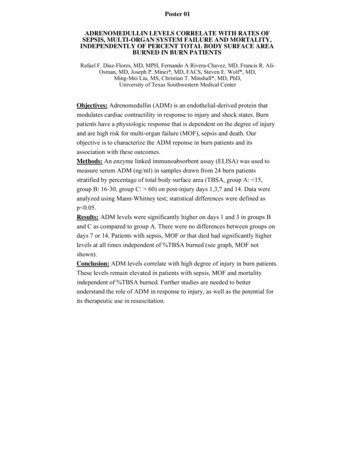
Transcription
Poster 01ADRENOMEDULLIN LEVELS CORRELATE WITH RATES OFSEPSIS, MULTI-ORGAN SYSTEM FAILURE AND MORTALITY,INDEPENDENTLY OF PERCENT TOTAL BODY SURFACE AREABURNED IN BURN PATIENTSRafael F. Diaz-Flores, MD, MPH, Fernando A Rivera-Chavez, MD, Francis R. AliOsman, MD, Joseph P. Minei*, MD, FACS, Steven E. Wolf*, MD,Ming-Mei Liu, MS, Christian T. Minshall*, MD, PhD,University of Texas Southwestern Medical CenterObjectives: Adrenomedullin (ADM) is an endothelial-derived protein thatmodulates cardiac contractility in response to injury and shock states. Burnpatients have a physiologic response that is dependent on the degree of injuryand are high risk for multi-organ failure (MOF), sepsis and death. Ourobjective is to characterize the ADM reponse in burn patients and itsassociation with these outcomes.Methods: An enzyme linked immunoabsorbent assay (ELISA) was used tomeasure serum ADM (ng/ml) in samples drawn from 24 burn patientsstratified by percentage of total body surface area (TBSA, group A: 15,group B: 16-30, group C: 60) on post-injury days 1,3,7 and 14. Data wereanalyzed using Mann-Whitney test; statistical differences were defined asp 0.05.Results: ADM levels were significantly higher on days 1 and 3 in groups Band C as compared to group A. There were no differences between groups ondays 7 or 14. Patients with sepsis, MOF or that died had significantly higherlevels at all times independent of %TBSA burned (see graph, MOF notshown).Conclusion: ADM levels correlate with high degree of injury in burn patients.These levels remain elevated in patients with sepsis, MOF and mortalityindependent of %TBSA burned. Further studies are needed to betterunderstand the role of ADM in response to injury, as well as the potential forits therapeutic use in resuscitation.
Notes
Poster 02PENETRATING VIOLENCE: A CALL FOR PREVENTIONJoan M. Pirrung*, RN, MSN, ACNS-BS,Pamela Woods*, RN, ACNS-BC, CEN, Michael Kalina*, DO,Kathleen Boyer, BSN, RN, CCRN, Mark D. Cipolle*, MD, PhD,Christiana Care Health System-Christiana HospitalObjectives: Violence is a major public health issue in the US and analarmingly new concern in a suburban trauma center. In 2009, the city'sviolent crime rate average was higher than the national average and has one ofthe highest crime rates per capita nationally. Over a 10 year period, thetrauma center's registry catalogued an increase in gun shootings by 62%.Therefore, injury prevention efforts are focused in high-risk violent crimeareas. The initial effort was to create a short film depicting real life situationsknown to glorify gang membership along with medical and legalconsequences related to gun violence.Methods: In partnership with the US Attorney 's Office, a local filmproduction company, city officials and trauma center clinicians, a short filmwas written and produced. The film is part of a violence prevention programpresented in the following format: 1) view the short film, 2) lecture by a USAttorney representative on the legal consequences of violent activities and 3)lecture by a trauma clinician on physical injuries and emotional harmassociated with gun violence.Results: Since the premier of the violence prevention program in October of2011, 56 programs have been conducted reaching 2000 at-risk youths, youngadults and parents. Eight hundred and forty eight post-program surveys weredistributed with 603 (71.1%) returned. Of those who returned the survey: 1)97.8% responded that the film and presentation provided informationinfluencing positive choices to avoid gun and gang violence, 2) 95.2% feltthat they increased their knowledge regarding negative consequencesassociated with gang membership, and 3) 91.9% responded that they wouldrecommend the film and presentation.Conclusion: There has been overwhelmingly positive feedback on the contentof the short film and associated presentations. Future plans are to develop adocumentary including live footage in the trauma bay with interviews frommedical experts and gang members on the impact of violence in thecommunities.
Notes
Poster 03MORTALITY INCREASES WITH REPEATED EPISODES OFNON-ACCIDENTAL TRAUMA IN CHILDRENKatherine Deans, MD, MHSc, Johanna R Askegard-Giesmann, MD, Jonathan I.Groner*, MD, Jonathan Thackeray, MD, Peter C Minneci, MD, MHSc,Nationwide Children's HospitalObjectives: Non-accidental trauma (NAT) is a leading cause of childhoodtraumatic injury. The objective of this study was to assess the mortality risk inchildren who are victims of repeated episodes of NAT.Methods: Using the Ohio State Trauma Registry, we identified the records ofall patients 16 years of age hospitalized between 2000-2010 with an ICD-9code for NAT. Potential victims of repeated episodes of NAT were identifiedby using data matches between records within the registry for all of thefollowing elements: date of birth, race, and gender. We subsequently appliedtemporal sequencing to eliminate records where death occurred prior to thesecond record. Statistical comparisons were made using Fisher's exact andWilcoxon rank sum tests.Results: 1,572 victims of NAT were identified with 53 patients meetingcriteria for repeated episodes of NAT. Compared to patients with a singleepisode of NAT, patients with repeated episodes of NAT were more likely tobe male (66% vs. 52%, p 0.05), white (83% vs. 65%, p 0.03), evaluated at apediatric trauma center (87% vs. 70%, p 0.008), and were more likely to die(24.5% vs. 9.9%, p 0.002). Within the group of children who sufferedrepeated NAT, black patients were more likely to die (57% vs. 20%, p 0.05).Patients who died with repeated episodes of NAT had a longer interval frominitial episode to second episode (median (IQR): 527 days (83-1099) vs. 166days (52-502), p 0.07) and were older during their second episode of NAT (1year (0-3) vs. 0 years (0-1, p 0.05). At initial presentation, lower extremityfractures (p 0.09) and liver injuries (p 0.06) were reported more commonlyin non-survivors of repeated episodes of NAT.Conclusion: Mortality is significantly higher in children who suffer repeatedepisodes of NAT. Therefore, it is critically important to accurately identify achild's initial episode of NAT. Subsequently, appropriate resources andfollow-up should be provided to these children to prevent future catastrophicepisodes of NAT.
Notes
Poster 04ENDOTRACHEAL TUBE REPOSITIONING: HOW ACCURATE?Ming-Li Wang, MD, Kevin M. Schuster*, MD,Bishwajit Bhattacharya*, MD, Adrian A Maung*, MD,Lewis J. Kaplan*, MD, FACS, FCCM, FCCP, Kimberly A. Davis*, MD,Yale University School of MedicineObjectives: Sub-optimal positioning of endotracheal tubes (ETs) is oftenidentified on routine chest radiographs prompting adjustment. The accuracyof ET adjustments based on tube measurement markings at the incisors hasnot been reported.Methods: We performed a one-year prospective observational study of allsurgical ICU patients requiring repositioning of their ET based on chest x-ray(CXR). The ET was repositioned by a respiratory therapist using tubemarkings at the incisors and follow up CXRs were obtained within 2 hours.CXR tube locations were compared to the planned intervention. Mean,median, interquartile range (IQR) and chi-square results are reported.Results: Fifty five patients met inclusion criteria and had a complete set ofdata (80% male). The most common sub-optimal positioning was an ETrequiring advancement (80%). Patients requiring ET withdrawal were morelikely female (8/11, p 0.001). The mean difference between the planned andactual intervention was 1.55cm (95% CI 1.16cm – 1.95cm) achieving a meanof 40% of the planned intervention (95% CI 29.0% - 51.0%). Foradvancement the median starting position was 7.10cm (IQR 2.20cm) from thecarina with a median planned advancement of 2.00cm. The actualadvancement was a median of 1.15cm, achieving 57.5% of the goal. For thewithdrawal group the median starting position was 0.70cm (IQR 1.05cm) fromthe carina with a planned median withdrawal of 2.00cm (IQR 0.75cm). Theactual withdrawal was a median of 1.00cm, achieving 50.0% of the goal.There was no correlation between the original location or the plannedintervention and the accuracy of the intervention (figure). In three cases theET moved opposite of the planned intervention.Conclusion: ET re-positioning based on measurement at the incisors isinaccurate. Magnitude of the intervention did not correlate with the degreeof inaccuracy. Blind repositioning of ETs should be abandoned or followup CXRs obtained.
Notes
Poster 05THE ECONOMIC IMPACT OF INTENSIVIST FELLOWSHIPTRAININGJeffrey Carter, MD, Daryhl L. Johnson, II*, MD, MPH,Renae Stafford*, MD, Preston B. Rich*, MDUniversity of North CarolinaObjectives: Rising medical student debt and changes in physicianreimbursement patterns are requiring residents to carefully examine theirreturn on investment (ROI) for fellowship training. At the same time, there isa growing shortage of intensivists, especially surgical intensivists which areevolving into acute care surgeons. Our goal was to analyze the ROI ofintensivist fellowship training in private and academic practice.Methods: Using survey data from the Association of American MedicalColleges and the Medical Group Management Association, we calculated theROI of acute care surgery, pediatric, and medical intensivists in today'sdollars. Our financial analysis incorporated average medical debt, annualincome, and federal income tax into a net present value (NPV) calculation ata 5% discount rate with career duration from internship to retirement at age65. Relative career value was defined as the ratio of intensivist to generalistNPV.Results: Over 17,000 specialty specific responses were included in theanalysis. Private practice physicians had a relative career value (RCV)15-66% higher than their academic counterparts. Academic acute caresurgeons and medical intensivists decreased their RCV by 5% and 3%respectively compared to academic general surgeons and medical internists.Academic pediatric intensivists increased their RCV by 20% compared toacademic pediatricians. Private practice acute care surgeons increased theirRCV by 7% compared to their private practice general surgeons but remainedbelow average for fellowship-trained surgeons.Conclusion: Academicians have lower relative career values when comparedto private practitioners. Academic acute care surgeons have the lowest relativecareer value, which calls into question the ROI and future recruitment into thespecialty. Resolving the intensivist shortage will require further analysis ofthe financial implications of critical care training when compared toalternative career paths.
Notes
Poster 06DEATH BY NUMBERS: HOW DO TQIP AND UHC COMPARE?Lillian S Kao, MD, MS, Miriam Morales, MS, Avery B. Nathens*, MD, PhD, MPH,Edmund P Dipasupil, CSTR, CAISS, Sheila Lopez, RN, BSN, MA, Toni vonWenckstern, RN, MS, John B. Holcomb*, MD, Rosemary Kozar, MD, PhD,University of Texas Health Science Center at HoustonObjectives: The Trauma Quality Improvement Program (TQIP) and theUniversity HealthSystem Consortium (UHC) provide risk-adjusted mortalityrates to participating hospitals. TQIP includes a more severely ill subset oftrauma patients (ISS 9) than UHC and is considered the gold standard fortrauma quality improvement and benchmarking. The two programs calculatetheir mortality models based on different components. We hypothesized thatTQIP would more accurately predict mortality.Methods: Patients who were admitted to a Level I trauma center in 2009 andwere in both the TQIP and UHC databases were included. Goodness-of-fittests (p 0.05 indicates the model does not fit the data) and areas under thereceiver operating characteristic (ROC) curves were performed for the twomodels for mortality. Agreement between expected mortality rates wereexamined using the Bland-Altman method (Stata SE v12).Results: Of 2753 TQIP patients, 2490 patients were in the UHC database.The p-values for the goodness-of-fit tests were not significant. There was nodifference in the area under the ROC curves for mortality 94.1% for TQIPand 93.6% for UHC (p 0.87). As assessed using the Bland-Altman method(FIgure), agreement was excellent when predicted probability of death waseither low ( 20%) or high ( 70%).Conclusion: Both UHC and TQIP models predicted mortality with similarlyhigh accuracy. However, there are differences in a small proportion ofpatients whose outcomes might be most amenable to intervention. Thesedifferences might be explained by different model characteristics or,alternatively, by unique attributes of specific patient populations. As thesedifferences occur in a population where outcomes might be modifiable, it iscritically important to understand the limits of quality improvement programsbased on external benchmarking approaches.
Notes
Poster 07ADHERENCE TO PRBC TRANSFUSION TRIGGER GUIDELINES ISIMPROVED WITH ELECTRONIC CLINICAL DECISION SUPPORTRachael Callcut*, MD, MSPH, L. Tim Goodnough, MD, Steven Philips, BS,Paul Maggio, MD, MBA, Stanford UniversityObjectives: Despite evidence based guidelines supporting a restrictivetransfusion strategy in hemodynamically stable critically ill patients,physician practice remains variable. Traditionally, educational initiatives havebeen employed to improve compliance, however, the improvements aremodest. In contrast, electronic real-time clinical decision support (CDS) hasnot been previously studied and may provide additional benefit for reductionof unnecessary packed red blood cell transfusion (PRBC).Methods: A prospective, cohort of all med-surg ICU patients was followedfrom September 2008 to August 2011 and in hospital transfusion data wascollected. All hemodynamically stable, non-hemorrhaging ICU patients wereincluded in this analysis. An educational initiative was introduced in fiscalyear 2010 and a CDS alert in 2011. Physician were notified via thecomputerized order entry CDS alert if the PRBC transfusion was outside ofhospital guidelines. Compliance to trigger guidelines was compared in thepre-intervention (PI) vs. the educational (EDUC) initiative vs. CDS alert year.Results: Compliance with PRBC trigger guidelines improved with thegreatest benefit seen after introduction of the real-time CDS alert (PI 48%,EDUC 52%, CDS 69%, p 0.0001, FIGURE) . The mean ( /- SEM)pre-transfusion hemoglobin was unchanged after introduction of theeducational initiative (baseline 8.3 /- 0.1 g/dL vs. 8.2 /- 0.1, p NS),however, there was a significant decrease with the CDS alert (mean 7.6 /0.1, p 0.0001). Transfusions per ICU day at risk also markedly decreasedwith the CDS alert compared with the PI and EDUC years (PI 9.8%, EDUC8.9%, CDS 5.9%, p 0.0001). There was no change in mortality or case mixindex during the study.Conclusion: Implementation of real-time CDS improves compliance withevidence based transfusion trigger guidelines for critically ill patients.
Notes
Poster 08OUTCOMES OF PRE-HOSPITAL VERSUS IN-HOSPITALINTUBATION IN TRAUMA PATIENTS - DOES LOCATIONMATTER?Christopher Stephens, MD, Jay Menaker*, MD, Jeffrey Glaser, MSII,Nicholas T Tarmey, FRCA, Daniel Mayer, BS, Mary E Kramer, RN,Deborah M. Stein*, MD, Thomas M. Scalea*, MD, FACS, FCCM,University of Maryland School of Medicine - R Adams CowleyShock Trauma CenterObjectives: Controversy exists on the association of outcome after injurywhen comparing in-hospital versus pre-hospital intubation. The purpose ofthis study was to evaluate outcomes based on location of intubation.Methods: Over a 9-month period, patients intubated in the field (FI) or within60 minutes of arrival to the trauma center (TCI) were prospectively enrolled.Patients with cardiac arrest or those transferred were excluded. Demographics,admission physiology, Injury Severity Score (ISS), Glasgow Coma Scale(GCS), hospital length of stay (HLOS), intensive care unit (ICU) LOS,ventilator days, field time when available, and mortality were collected.Multivariate analysis was used to determine the independent effect of locationof intubation on in-hospital mortality.Results: 422 patients were identified. 102(24%) patients were FI and320(76%) were TCI. In the FI group, 86(84%) had blunt and 12(12%)penetrating injuries. In the TCI group, 248(78%) blunt, 65(20%) penetrating.There was no significant difference in age between the two groups. FI patientshad significantly higher ISS (27.8 vs. 20.7, p 0.0001) and lower GCS (4.8vs.10.8, p 0.0001). FI patients had significantly longer field time (1.3 vs. 0.8hours, p 0.0001). In unadjusted analysis, FI patients had significantly highermortality rates (40% vs.15%, p 0.0001) and ventilator days (7.2 days vs. 5.5days, p 0.004). ICU and HLOS were not significantly different (6.3 days vs.4.6 days, p 0.063; 8.9 days vs. 7.8 days, p 0.95). In adjusted analysis, therewas no difference in outcome based on location of intubation with respect tomortality, HLOS, ICU LOS, and ventilator days.Conclusion: Despite previous reports, in a mature trauma system, fieldintubations are not independently associated with worse outcomes. Furtherstudies are needed to determine the ideal location of intubation to improveoutcome following injury.
Notes
Poster 09OUTCOMES FOLLOWING SUPERSELECTIVEANGIOEMOBLIZATION FOR GASTROINTESTINALHEMORRHAGEDavid King*, MD, Hasan B Alam, MD, Oscar A Birkhan, MD, Catrina M Cropano,BS, Marc A. deMoya*, MD, Ayesha M Imam, MD, Sanjeeva Kalva, MD, Antonios CSideris, MD, George C Velmahos, MD, T Gregory Walker, MD,Ali Y Mejaddam, M.D., Massachusetts General HospitalObjectives: Therapeutic angioembolization is a relatively new treatmentmodality for gastrointestinal hemorrhage (GIH). The purpose of our study isto evaluate the safety and effectiveness of transcatheter superselectiveangioembolization (SSAE) for the treatment of GIH.Methods: A retrospective review of consecutive patients who underwentSSAE for GIH between January 2001 and June 2011 was performed. Allpatients with evidence of active contrast extravasation described on theradiology report were included. Data was collected on demographics,co-morbidities, clinical presentation, and type of intravascular angioembolicagent used. Outcomes included technical success (cessation of extravasation),clinical success (no rebleeding requiring intervention within 30 days), andincidence of ischemic complications.Results: 98 patients underwent SSAE for GIH during the study period; 47were excluded due to lack of active contrast extravasation. Of the remaining51 patients, 22 (43%) presented with a lower GIH and 29 (57%) with upperGIH. The majority were embolized with a permanent agent (71%), while theremaining patients received either a temporary agent (16%) or a combination(14%). The overall technical and clinical success rates were 98% and 71%,respectively. Of the 15 patients with rebleeding, 4 were managed successfullywith re-embolization, while 2 underwent endoscopic therapy, and 9 hadsurgical resections. Only one patient had a major ischemic complication(jejunal infarction) requiring resection.Conclusion: SSE, with re-embolization if necessary, is an effective treatmentmodality for active GIH in 80% of patients. Ischemic complications areextremely rare.
Notes
Poster 10DVT IN TRAUMA PATIENTS: INJURY RELATED, NOT AMEASURE OF QUALITY OF CAREMeredith S. Tinti*, MD, Adam M. Shiroff*, MD, Marianne Boylston, Nonmember, Vicente H. Gracias*, MD, UMDNJ-Robert Wood Johnson U HospitalObjectives: Due to Pay for Performance and new organizational definitionsof quality of care, various conditions are being labeled as non-acceptablecomplications of health care. Deep venous thrombosis (DVT) is one conditionthat has been targeted as a measure of quality of care. We hypothesized thatDVT is often related to mechanism of injury and not a lack of care providedby a health care institution.Methods: A retrospective study was performed by querying the TraumaRegistry at our Level 1 Trauma Center for all patients that were diagnosedwith a DVT or pulmonary embolism (PE) between January 2005 andDecember 2011. The data was then analyzed with regard to hospital daysuntil diagnosis was made and with regard to mechanism of injury.Results: 288 patients with a diagnosis of DVT or PE were identified (2.67%of all Trauma patients) during the time period. 7.6% were diagnosed within24 hours of admission. 11.1% were diagnosed between 24 and 48 hours and12.2% between 48 and 72 hours. 30.9% of DVT/PE's were diagnosed in lessthan 72 hours from admission. Additionally, the rate of DVT amongst patientswho required extrication from a vehicle at the scene was 5.88%, 2.2 times therate in our general trauma population.Conclusion: Although our DVT/PE screening process does not routinelyevaluate patients for these conditions until hospital day 3 or 4, nearly onethird of our patients with thromboembolic events were diagnosed in less than72 hours from the time of admission. The fact that the DVT/PE rate is twice ashigh in patients with a documented extrication time at the scene of the injury,supports the theory that these events are related to mechanism of injury. Theearly thromboembolic events should be considered to be present on arrival orinjury related and should not be used as measures of quality of care. Earlyscreening methods may help elucidate this further.
Notes
Poster 11INTERMOUNTAIN RISK SCORE IS HIGHLY PREDICTIVE OFMORTALITY IN TRAUMA PATIENTSSarah Majercik, MD, MBA, FACS, Benjamin Horne, PhD, MPH, FACC, StaceyKnight, PhD, MStat, Jolene Fox, RN, Mark H. Stevens*, MD, FACS,Intermountain Medical CenterObjectives: The Intermountain Risk Score (IMRS) uses components of theadmission complete blood count (CBC) and basic metabolic profile (BMP) topredict mortality. IMRS has been validated in medical and cardiologypatients, but has not been evaluated in trauma patients. This study testedwhether IMRS is predictive of mortality in a trauma population at a LevelOne trauma center.Methods: Admitted trauma patients with CBC and BMP from October, 2005-December, 2011 were evaluated. Sex-specific 30-day and 1-year IMRSvalues were calculated using multivariable modeling of components of theCBC, BMP, and patient age. Three risk thresholds were established (high,medium, low). Actual mortality was determined using the medical record andSocial Security Administration death data.Results: 3637 females and 5901 males were evaluated at 30 days and 1 year.IMRS was highly predictive of death at 30 days (c 0.772 for females,c 0.783 males) and 1 year (c 0.778 for females, c 0.831 males). Coxregression analysis, adjusted for injury severity score, blunt vs. penetrating,and length of stay, showed increased mortality risks among patients in themoderate and high risk IMRS-defined groups at both 30 days and 1 year, withhazard ratios (table) ranging from 4.96-57.88 (all p 0.001).Conclusion: IMRS strongly predicts mortality in trauma patients at thissingle Level I trauma center. The ability to quickly and accurately determine apatient's mortality risk at the time of admission makes IMRS a powerful andpotentially clinically important tool.
Notes
Poster 12UNCONTROLLED HEMORRHAGIC SHOCK RESULTS IN AHYPERCOAGUABLE STATE MODULATED BY INITIAL FLUIDRESUSCITATION REGIMENSGordon M Riha, MD, Nicholas R Kunio, MD, Philbert Y Van, MD,Igor Kremenevskiy, MD, PhD, Ross Anderson, BS, Gregory J Hamilton, BS,Jerome A Differding, MPH, Martin A. Schreiber*, MD, FACS,Oregon Health & Science UniversityObjectives: Previous studies have shown large volume resuscitationmodulates coagulopathy and inflammation. Our objective was to analyze theeffects of initial bolus fluids utilized in military and civilian settings oncoagulation and inflammation in a prospective, randomized, blinded trial ofresuscitation of uncontrolled hemorrhage.Methods: Fifty swine were anesthetized, intubated, ventilated, and hadmonitoring lines placed. A grade V liver injury was performed followed by30 minutes (30') of hemorrhage. After 30', the liver was packed, andrandomized fluid resuscitation was initiated over a 12' period with two litersof normal saline (NS), two liters of Lactated Ringer's (LR), 250 ml of 7.5%saline with 3% Dextran (HTS), 500 ml of Hextend, or no fluid (NF). Animalswere monitored for 2 hours post-injury. Thrombelastograms (TEGs),prothrombin time (PT), partial thromboplastin time (PTT), fibrinogen, as wellas serum IL-6, IL-8, and TNF-α levels were drawn at baseline, 1 and 2 hours.Results: The NF group had less post-treatment blood loss compared to othergroups, p 0.01. Blood loss was similar in the other groups. TEG R-values ineach group were decreased at 1 and 2 hours compared to baseline, p 0.02(Figure 1). NS, HTS, and HEX had lower TEG-MA values compared to NF,p 0.02. All fluids except LR resulted in significant increases in PT anddecreases in fibrinogen compared to NF, p 0.02. Fluid resuscitation groupsas well as the NF group demonstrated significant increases in inflammatorycytokines from baseline to 1 hour and baseline to 2 hours. There were nosignificant differences in inflammatory cytokines between groups at 2 hours(Figure 2).Conclusion: Withholding fluid resulted in the least significant change in PT,fibrinogen, and MA, and the lowest post-treatment blood loss. Resuscitationwith different initial fluid resuscitation strategies did not result in increasedpro-inflammatory mediators compared to no fluid.
Notes
Poster 13EVALUATION OF THE RISK OF NONCONTIGUOUS FRACTURESOF THE SPINE IN BLUNT TRAUMADaniel W Nelson, DO, Matthew J. Martin*, MD, Niels Douglas Martin*, MD,Alec Beekley, MD, Madigan Army Medical CenterObjectives: There is significant debate over the risk of additionalnoncontiguous (NC) fractures among blunt trauma patients with an identifiedspinal injury, often prompting routine full spine imaging. We sought todetermine the incidence of NC spinal fractures and the relationship betweeninjury pattern and mechanism.Methods: A review of all adult blunt trauma patients from the 2010 NationalTrauma Databank with a spine fracture. Patient demographics, mechanism ofinjury and frequencies of all combinations of spinal fractures were analyzed.Results: Among 654,052 blunt trauma patients, 83,338 (13%) had adiagnosed spine fracture. The mean ISS was 15 11. Of these, 7% (5,496)sustained spinal cord injury and 17% (14,413) underwent spinal surgery. Theoverall incidence of NC fractures was 22% and was associated with severetruncal injuries, primarily involving the chest. The relative incidences ofcervical, thoracic and lumbar fractures were 41% (34,480), 37% (30,383), and43% (35,778) respectively. Rates of NC fractures of the spine included 9%(7,406) cervicothoracic, 4% (3,415) cervicolumbar, and 10% (7,929)thoracolumbar. The slight majority (57%) of patients with spinal fracturessustained high velocity trauma compared to 43% associated with low velocitytrauma. However, NC fractures of the spine were strongly associated withhigh velocity trauma (Figure).Conclusion: Spine fractures are relatively common with blunt trauma, andapproximately 20% will have a NC fracture. NC fractures were associatedwith other severe injuries and should be mainly suspected and investigated inhigh velocity mechanisms.
Notes
Poster 14INCREASED MORBIDITY AND MORTALITY OF TRAUMATICBRAIN INJURY IN VICTIMS OF NONACCIDENTAL TRAUMAKatherine Deans, MD, MHSc, Peter C Minneci, MD, MHSc,Wendi Lowell, CAISS, Jonathan I. Groner*, MD,Nationwide Children's HospitalObjectives: The purpose of this study was to determine if the morbidity andmortality associated with traumatic brain injury (TBI) is worse in childrenwho are victims of nonaccidental trauma (NAT) compared to TBI from othertraumatic mechanisms.Methods: We identified all pediatric patients admitted with the diagnosis ofTBI between 2001-2010 in our institutional trauma registry with anAbbreviated Injury Score (AIS) 1. Patients were divided into groups basedon a nonaccidental (NAT) or accidental mechanism of injury. Need forgastrostomy tube insertion was used as a marker of more severe neurologicmorbidity in survivors of TBI. Group comparisons were made using Fisher'sexact tests.Results: 2,782 patients with TBI were included. 315 (11.3%) patients had TBIsecondary to NAT. Overall mortality and AIS-specific mortality were higherin patients with TBI secondary to NAT (Table). In comparison to patients withTBI secondary to accidental mechanisms, patients with TBI secondary to NATwere younger (mean 1 vs. 8 years), had longer ICU stays (mean 3 vs. 1 days),and required gastrostomy tubes more often (6% vs. 1%, p 0.0001). Evenamongst the subgroup of patients with severe TBI, (AIS 4 and 5), patientswith NAT required gastrostomy tubes more often (5% vs. 2%, p 0.014).Conclusion: Patients with TBI from NAT have increased morbidity andmortality compared to patients with TBI from accidental mechanisms; thesedifferences are present at all levels of severity of injury. Patients with TBIfrom NAT represent a vulnerable group of pediatric trauma patients that are atincreased risk of death and worse outcome and that will require greater shortand long term medical resources.
Notes
Poster 15MAINTENANCE OF NORMOTHERMIA IMPROVES FUNCTIONALOUTCOME IN SEVERE CLOSED HEAD INJURY PATIENTSKara E Friend, MD, L. D. Britt*, MD, Rebecca C Britt, MD,Jessica Robin Burgess, MD, Jay N. Collins*, MD,Timothy J. Novosel*, MD, Leonard J. Weireter Jr.*, MD,Eastern Virginia Medical SchoolObjectives: The deregulation of the hypothalamic axis and subsequenthyperthermic response have been shown to be deleterious to full recovery inclosed head injuries. Cooling catheters have been suggested to maintainnormothermic states.Methods: All patients age 18-80 diagnosed with severe closed head injuryfrom June 2010 – May 2012 were evaluated. Cooling catheters were placed inthe femoral vein within 24 hours of admission. Cooling catheters maintainedthe patient at 97 degrees Fahren
University of Texas Southwestern Medical Center Objectives: Adrenomedullin (ADM) is an endothelial-derived protein that modulates cardiac contractility in response to injury and shock states. Burn patients have a physiologic response that is dependent on the degree of injury and are high risk for multi-organ failure (MOF), sepsis and death. Our



